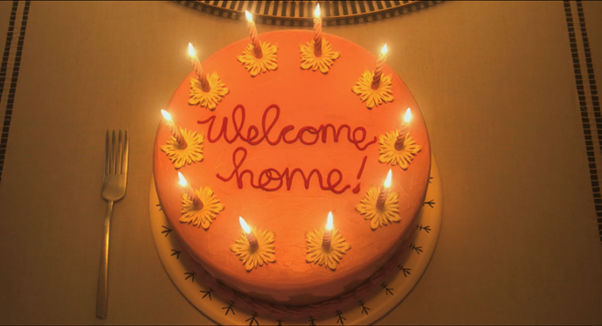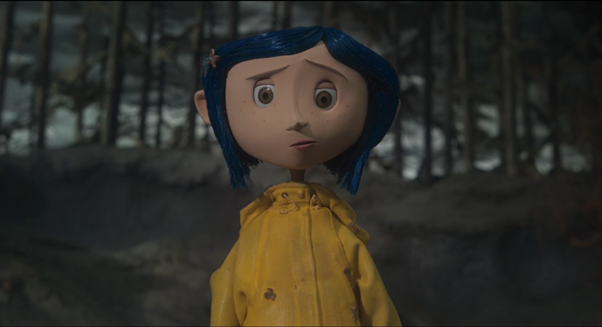Figure 1: Coraline’s “welcome home” cake, Henry Selick (dir.), Coraline, 2009. USA © Focus Features.
When the eleven-year-old Coraline Jones discovers a small door in her new house to be a portal to an “Other World,” she is welcomed by two exact copies of her parents into an exact replica of her house. Throughout her visit, she is seduced by a warm, colorful environment and a delicious dinner, where at the end her “Other Mother” serves her a “welcome home” cake (Figure 1). With a closer look, the letter “o” in the word “home!” on the cake is double-looped. According to graphology, the analysis of handwriting, the letter “o” is said to be the most indicative of lying. In particular, the double-looped “o” has been noticed in almost every pathological liar’s handwriting (Dolen). Thus, one small graphic detail may hold enormous meaning: it seems to suggest that Coraline is “welcome,” but she is not at “home.” The choice to include this subtle detail is indicative of how director Henry Selick worked to create one of the uncanniest horror animation films in cinema history. Coraline (2009) is based on a novel by British author Neil Gaiman, published in 2002. Though the book is intended for children, the story is incredibly dark, and, especially after the animated adaptation, it often led adults to question whether it is appropriate for such a young audience. Coraline (voiced by Dakota Fanning) has just moved to a new place with her family, the Pink Palace Apartments in Ashland, Oregon – or what looks like an isolated mansion in the middle of nowhere. Because both of her parents (voiced by Teri Hatcher and John Hodgman) are too busy with their jobs to pay attention to her, Coraline spends most of her time alone, wandering in and out of the house. The place’s aura is gloomy and mysterious from the beginning, especially as strange things start to manifest. Among these, her neighbor Wyborne (voiced by Robert Bailey Jr) gives her a button-eyed ragdoll he has found, because it looks exactly like her. In fact, it is the doll that leads Coraline to discover the portal to the Other World, which seems to offer everything that her real world is lacking – including attentive parents. However, even in the Other World something seems to be off from the beginning. Beyond the fact that, like the doll, Coraline’s other parents have black buttons instead of eyes – an incredibly unsettling detail that makes them distorted copies of her real parents – the Other World is permeated by an eerie atmosphere. Like the presence of doppelgängers, the story features typical traits of gothic horror: isolated and decadent locations, gloomy weather, mystery, an evil creature, and ghosts. All these elements contribute to evoking unnerving feelings, in both Coraline and the audience. Gaiman’s novel incorporates this aesthetics to further embody trauma, feelings of uncertainty, and loneliness in a neglected child and plunges them into a fantasy world that, despite seeming to comfort Coraline’s internal conflicts, appears to function in the exact opposite direction. In this regard, the attention given to small details in the film serves as a crucial factor in perpetuating the sense of uncanny, as everything in Coraline generates fear through subtlety. Among the many cinematic tools that would need to be analyzed in this frame, in this article I focus on the elaborate use of colors, the employment of stop-motion animation, and the omnipresence of insects throughout the film, to show the importance of details in the creation of the anxiogenic climax that characterizes one of the most unsettling, yet elegant, animated films in cinema history.
The Interrelationship Between Color Palette, Space, and Character Subjectivity
The choice of colors in Coraline is not random. In the first part of the film, before Coraline enters the Other World, the color palette centers around three colors: gray, blue, and purple. In fact, apart from blue and purple, almost all colors in this part are faded and resemble shades of gray. The atmosphere the film sets from the beginning is gloomy, as the sky is cloudy, and the weather is rainy and misty. The house where Coraline’s family moves in is pink, a playful color that, according to the psychology of colors in Western culture, is usually associated with sweetness, innocence, femininity, or beauty (Risk). However, the Pink Palace in Selick’s world is faded and discolored, it looks old and decadent, as if suggesting that those values traditionally associated with pink were faded too. Coraline’s parents also wear faded or dark colors, as well as all her neighbors, who seem a little decadent themselves, and almost grotesque at times. In contrast, Coraline character’s color palette is bright – her hair and nails are electric blue, and she often wears a bright yellow raincoat. Besides being a cheerful color that refers to childish characteristics of naivety and spontaneity, it is interesting to note how yellow is also associated with insecurity and obsession (Risk). At the beginning of the film, Coraline is visibly lonely in a new house where she did not want to move in the first place.
Figure 2: Coraline exploring outside the Pink Palace, Henry Selick (dir.), Coraline, 2009. USA © Focus Features.
Like writer Robin Moon, many have analyzed Coraline in the frame of child neglect, since her parents are unable to pay her attention. Although she acts as if she does not care, Coraline is constantly begging for attention, “tied to a dependence on her parents to provide something they aren’t available for” (Moon), in a way that not only shows great insecurity but also gets slightly obsessive at times. For instance, she persistently asks her parents to do some gardening together while they are working, even when the weather outside is terrible. Most of the time when she does it, she is wearing her yellow raincoat. Moreover, Moon talks about Coraline’s insecurities as a consequence of being misunderstood not only by her parents, but by all the other people living in the Pink Palace, who do not even get her name right and call her “Caroline” (Moon). Thus, the presence of yellow in the film is not related to happiness: instead, it is interesting to note how Coraline is quite unhappy and wears yellow as a consistent habit. Here, yellow is used to outline patterns of insecurity and obsession in a bored neglected child, who is constantly trying to get her parents’ attention, as most children would do. Moreover, Coraline is the only child living in the Pink Palace: this is visually emphasized by her bright color palette which creates contrast not only with the environment but also with the other characters. After gray, blue is the color whose presence holds the most symbolic importance in the first part of the film. The recurrence of blue, starting from Coraline’s hair and nails, refers to cold, melancholy, and isolation – quite descriptive states of the protagonist’s feelings. But according to the psychology of colors, blue is also associated with peace and tranquility, as it tends to elicit a calming effect on the viewer (Risk). In the case of an eleven-year-old child though, it is not hard to imagine how such moods could lead to boredom. This association between blue and boredom is shown quite clearly in the film through the “exploration” sequence (accompanied by Bruno Coulais’s beautiful theme “Exploration”). One afternoon, Coraline is pestering her dad to do something together, so he suggests she goes to explore the new house and lists all the windows and the blue things she finds. While he thinks it will keep her busy, the task turns out to be extremely boring to Coraline, as she points out several times. Ultimately, it is interesting to note the use of blue in slow-burn horror films. Because of its association with the night, signifier of uncertainty and danger in the horror genre, by transitive property, the use of blue can evoke anxiety and tension (Lewis). The whole first part of the film, up until when Coraline first enters the Other World, is permeated by a slight tension, a weird sense of anxiety in front of the strange, unexplainable events that are taking place already. In particular, the association of blue with the night as a symbol of the unknown gains more meaning when Coraline finally enters the Other World, at night-time. Following the little button-eyed mice, she opens the small door which unveils a blue and purple tunnel leading to the Other World. Not surprisingly, blue in horror is also linked to the supernatural, amping up the “unreality” of a scene (Lewis). Similarly, purple is associated with fantasy and mysticism, but also with illusion and threat (Risk). Often in films, purple is an ominous color, the sign that something bad is about to happen – hence its presence’s significance during Coraline’s transition to the Other World. Ultimately, in the frame of visual analysis, there is a stark contrast between the real world’s colors and the Other World’s: the house is bright pink; the rooms are colored; even the other parents’ clothes are bright. Everything looks more alive, a better copy of Coraline’s discolored reality. In fact, this visual choice is nothing but the reflection of the Other Mother’s attempt to trick Coraline into believing that this version of the world is brighter. The morning after, when Coraline wakes up in her real bed, she is disappointed. She rushes downstairs to check the little door, which she finds not to be a portal anymore, just a door giving on to a wall of bricks. The line between what is known and what is not gets so thin that Coraline is not even sure if the Other World has an independent existence, or if she only dreamed about it during the night. Hence the night – and its colors, blue and purple – acts as a frame for uncertainty, a time when anything could happen. Although more could be said about the use of colors over the course of the film, its analysis in the first part is already emblematic of its aim: not only colors are used to express the characters’ feelings, but they are also subtly employed to evoke specific emotions in the audience, thus contributing to creating the uncanny.
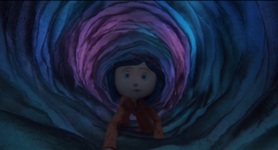
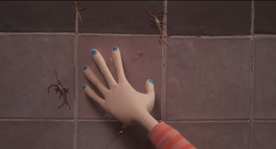
Figures 3 and 4: Coraline enters the Other World through the blue and purple tunnel; Coraline’s blue nail polish, Henry Selick (dir.), Coraline, 2009. USA © Focus Features.
Stop-Motion Animation as Indicative of Uncanny Feelings
The peculiarities of stop-motion animation contribute to the creation and development of the uncanny in the characters’ facial expressions, especially for Coraline and the Other Mother throughout the film. Because of the time-consuming process required by stop-motion animation, Coraline took four years in the making. Completing the film involved more than 500 people: principal photography alone took 18 months, and a total of 35 different animators had to work on the film, completing from 2.22 to 6.52 seconds of footage per week on average (LAIKA Studios). No doubt, the result is astonishing, but why undertake the hard path of stop-motion in a world where CGI already existed? Just like the use of colors, this choice has aesthetic reasons. Henry Selick, in his own words, had to “fight” for the movie to be made using stop-motion animation: “Coraline may be a fairy tale, but it is set in our times, modern times, and stop-motion animation brings a charm, a warmth. It takes a little bit of an edge off the darkest, most troubling parts of the story, I think, and adds a little creepiness to parts that might be too sweet” he declared in an interview for Focus Features. He believed the story’s soul was made for stop-motion. In the late 2000s there was a lot of research about the science of facial communication in film, and Coraline’s character has got an “incredible array of expressions” (“Henry Selick”). In fact, in the film, there are several moments in which her expression or gestures say more about how she is feeling than any spoken word could do. This is something that could not be achieved by CGI as the very nature of stop-motion technique is based on series of separated photographs that are later rendered in twenty-four frames per second. In other words, the technique elicits the impression of reality, thus adding to its overall uncanny aura. This is particularly evident during her first visit to the Other World. When she first meets the Other Mother (also voiced by Teri Hatcher), Coraline is suspicious. Undoubtedly, she looks better, happier, and friendlier than her real mother and yes, physically, she looks the same. Even the Other Father (also voiced by John Hodgman) is better dressed, plays the piano, and looks more alive than Coraline’s real father. Yet when he plays for her, he gives her a funny performance to which Coraline reacts as Figures 5 and 6 show: everything is amusing, but something does not feel right. The Other World is a better, yet distorted copy of a familiar scenario – so again, it is the distortion of the familiar that makes it so uncanny. By Freudian definition, the uncanny is “the unheimlich” (the un-homely), a home that is not quite a home (Moon), like the cake’s double-looped “o” suggests. It thus provokes feelings of uncertainty, confusion, and unsettlement.
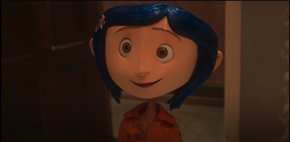
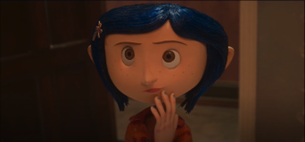
Figures 5 and 6: Coraline’s first and second reaction to Other Dad’s performance, Henry Selick (dir.), Coraline, 2009. USA © Focus Features.
The first time Coraline visits the Other World her facial expressions embody these feelings, alternating between astonishment and skepticism, enthusiasm and preoccupation (Figures 5 and 6). The way she is feeling is never verbally explicit though – it is only communicated through her face. This contributes to creating an atmosphere of unsettlement and uncertainty, an increasing sense of tension that the audience experiences too. As Selick explains, “There are six or seven main expressions, but in Coraline we wanted to add a layer of subtlety to those” (“Henry Selick”), which was not possible to construct with the hyperreal tenacities of CGI technique.
Character Physicality and Subtle Progression of Uncanniness
In fact, subtlety is a keyword when analyzing Coraline. In the Other World, there is one evident, uncanny detail to differentiate the doppelgängers from the “real”: their button eyes. Besides, they look quite “normal.” However, they all undertake some sort of physical transformation every new visit Coraline pays to the Other World, a process that the eye perceives but does not grasp unless it pays close attention, because again: it is in the details. In particular, the Other Mother’s character and costume design evolves and changes gradually, as she is slowly turning into her real insectoid form.
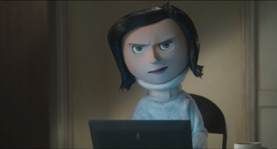
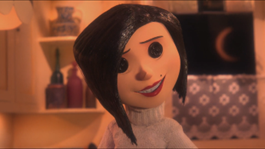
Figures 7 and 8: Coraline’s real mother and Coraline’s Other Mother, Henry Selick (dir.), Coraline, 2009. USA © Focus Features.
In a Laika Studios archives video, costume designer Deb Cook goes through the changes taking place in the Other Mother’s costume, beginning from the differences between her and Mel Jones (Coraline’s real mother). As she explains, “the subtle differences here are in the materials and treatment of the costume” (LAIKA Studios). Mother’s sweater is “slumpy,” her jeans are “loose,” her red sneakers are “pretty worn in,” and “faded,” as is “her whole pallor.” Alternatively, the fabric of Other Mother’s pants is shiny, and “there is some subtlety in the pattern cutting where the pants kick out a little at the bottom,” her shoes are a brighter color, and the sweater is “slicker” and “tailored.” Regular mom is wearing a neck brace which in Other Mother is turned into a high-neck sweater, which is more “sophisticated.” Moreover, the Other Mother is wearing bright red lipstick and nail polish, a color associated with love and passion, but also with danger, violence, and power (Risk). Cook explains how her character’s evolution takes place in four stages. Stage two sees the Other Mother still very much human, though her dress has changed and presents “three armatured shapes” on the back, so that it “moves and looks like an insect tail, but it began life as a peplum on her dress.” In stage three, the Other Mother is taller and skinnier, she is wearing a black dress made of a metallic mesh fabric that recalls the pattern of her previous dress, with a pointier and elongated peplum on the back. In her final stage, she has developed a carapace silhouette, her skin is white and cracked, she has four metallic legs and she has reached her “full insect form.” The peplum has further evolved, and the dress pattern is maintained – it is the attention paid to these details to create the scary effect throughout the whole transformation process. The audience perceives the Other Mother’s evolution but does not clearly notice it until the final stages.
Conclusion
The importance of details in Coraline lies in the fact that they trigger certain sensations in the audience, but they do it subtly. They shape the film’s gothic horror atmosphere by creating uncanny scenarios, and by holding symbolic meanings. It is interesting to note that many of these details are not present, or explicit, in the original novel by Gaiman: the double-looped “o” on the cake, the recurrence of certain colors, or the evolution of Other Mother’s outfits. They were added in the film, together with one ultimate fascinating horror trope: the presence of insects: Coraline’s dragonfly hair clip, cockroaches in the bathtub (Figure 4), paper dragonflies hung to her bed, and the Other Father’s “gardening locust.” The Other Mother’s character itself evolves towards an increasing resemblance to a spider. From the beginning of the film, bugs are constantly present. More interestingly, their presence intensifies as the Other World vanishes, and consequently, Coraline’s situation becomes more precarious. In the last scene set in the Other World, the house’s living room is populated by insect-shaped furniture that has a life of its own; the climax of tension reaches its highest with the Other Mother morphing into her spider-like stage and transforming the room into a spiderweb. Insects and insect imagery in films usually signify death, decay, and wickedness. They are largely employed in horror films to create disgust, or to set a distressing atmosphere (Stewardson). Hence, the symbolic value of their presence in Coraline from the very beginning functions as an additive to the uncanny feelings that emerge and develop through the ingenious utilization of color palette, stop-motion, and costuming.
References
Billson, Anne. “Climate Science Teaches Us to Love Insects. Horror Films Tell Us to Hate Them. Who Will Win?” The Guardian, 3 Sept. 2021, https://www.theguardian.com/film/2021/sep/03/climate-science-teaches-us-to-love-insects-horror-films-tell-us-to-hate-them-who-will-win. Accessed 26 Sept. 2023.
“Coraline.” Laika, https://www.laika.com/our-films/coraline. Accessed 26 Sept. 2023.
Dolen, Deborah. Handwriting Analysis in Psychology: Basic Theory. Kindle Edition, 2006.
“Graphology.” Encyclopedia Britannica, 25 Apr. 2017, https://www.britannica.com/topic/graphology. Accessed 26 Sept. 2023.
“Henry Selick In Conversation.” Focus Features, 2 Sept. 2009, https://www.focusfeatures.com/article/henry_selick_in_conversation. Accessed 26 Sept. 2023.
LAIKA Studios. “LAIKA Archives: Deb Cook Revisits the Costumes of Coraline’s Other Mother.” YouTube, 13 Sept. 2022, https://www.youtube.com/watch?v=ACpsl-EAw5U&ab_channel=LAIKAStudios. Accessed 26 Sept. 2023.
Lewis, Shannon. “The Meaning of Blue in Horror.” Slow Burn Horror, 7 Jan. 2022, https://slowburnhorror.com/2022/01/07/the-meaning-of-blue-in-horror/. Accessed 26 Sept. 2023.
Moon, Robin. “‘How Fragile That Can Be’: The Uncanny, Childhood Identity, and Toxic Parenthood in Coraline.” Horror Obsessive, 2021, https://horrorobsessive.com/2021/01/21/how-fragile-that-can-be-the-uncanny-childhood-identity-and-toxic-parenthood-in-coraline/. Accessed 26 Sept. 2023.
Risk, Mary. “How to Use Color in Film: 50+ Examples of Movie Color Palettes.” Studiobinder, 27 Jul. 2020, https://www.studiobinder.com/blog/how-to-use-color-in-film-50-examples-of-movie-color-palettes/. Accessed 26 Sept. 2023.
Stewardson, Christopher. “So Many Legs, So Much Meaning: An Introduction to Bugs in Horror Cinema.” Arrow Video, Sept. 2022, https://www.arrowfilms.com/blog/features/so-many-legs-so-much-meaning-an-introduction-to-bugs-in-horror-cinema/. Accessed 26 Sept. 2023.
Author Biography
Costanza Chirdo graduated in English and Media from Goldsmiths University of London in 2021. Throughout the course of the degree, she developed her passion for film by writing essays on cinema and literature and screenplays. She is now pursuing an MSc in Strategies of Political and Public Communication at the School of Political Science “Cesare Alfieri,” University of Florence.

